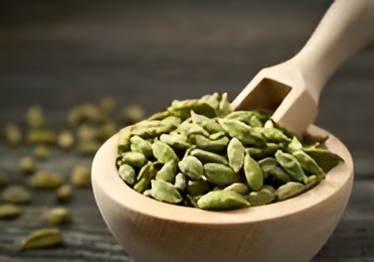Cardamom: The Aromatic Spice of Ancient Traditions

Cardamom, often referred to as the “queen of spices,” is a highly prized spice native to the Indian subcontinent and parts of Southeast Asia. Known for its distinct aroma and complex flavor, cardamom has been used in culinary and medicinal applications for thousands of years. This versatile spice comes from the seeds of plants in the ginger family and is available in several forms, including green, black, and white cardamom.
Types of Cardamom
Green Cardamom
Green cardamom (Elettaria cardamomum) is the most common variety, characterized by its small, green pods filled with tiny black seeds. Its sweet and slightly spicy flavor makes it a staple in both sweet and savory dishes. Green cardamom is widely used in Indian cuisine, especially in dishes like biryani, chai, and desserts.
Black Cardamom
Black cardamom (Amomum subulatum) has a much bolder flavor profile. Its dark brown, wrinkled pods emit a smoky aroma, making it ideal for hearty dishes, particularly in Indian and Nepali cuisine. Black cardamom is often used in meat dishes and stews, providing a depth of flavor that complements rich ingredients.
White Cardamom
In essence, white cardamom is simply bleached green cardamom. It has a milder flavor and is less common than its green and black counterparts. While it can be used in baking and desserts, it’s not as prevalent in traditional cooking.
Culinary Uses of Cardamom
Cardamom is incredibly versatile and can enhance a wide range of dishes. Its aromatic properties make it a favorite in both sweet and savory recipes.
Sweet Dishes
In baking, cardamom adds warmth and complexity. It’s commonly found in spice cakes, cookies, and pastries, particularly in Scandinavian and Middle Eastern cuisines. Cardamom is a key ingredient in the famous Indian dessert, gulab jamun, and is often used to flavor rice puddings.
Savory Dishes
In savory cooking, cardamom is used in spice blends like garam masala, which is foundational in many Indian dishes. It pairs well with meats, lentils, and vegetables, adding a fragrant touch that elevates the overall flavor profile. Cardamom-infused rice, such as in biryani, is a traditional delicacy that highlights its unique taste.
Beverages
Cardamom is widely used in beverages, particularly in chai tea, where it contributes to the drink’s signature flavor. It can also be found in coffee, especially in Middle Eastern cultures, where cardamom coffee is a popular choice.
Health Benefits of Cardamom
Cardamom is not only valued for its culinary uses but also for its potential health benefits. Rich in antioxidants, cardamom may help fight inflammation and protect against chronic diseases. Here are some of the health benefits associated with this spice:
Digestive Aid
Traditionally, cardamom has been used to treat stomach problems.It can help relieve bloating, gas, and discomfort, promoting a healthy digestive system. Drinking cardamom tea after meals is a common practice to support digestion.
Antimicrobial Properties
Research suggests that cardamom possesses antimicrobial properties, making it beneficial for oral health. It may help combat bad breath and reduce the growth of harmful bacteria in the mouth.
Respiratory Health
The spice is known to aid respiratory health, often used in traditional medicine to relieve coughs and congestion. Its warming properties can help soothe the respiratory tract, making it a popular choice in herbal remedies.
Cultural Significance of Cardamom
Cardamom holds a prominent place in various cultures. In India, it is often considered auspicious and is included in religious rituals and ceremonies. The spice is a symbol of hospitality and is commonly offered to guests.
In Traditional Medicine
In Ayurvedic medicine, cardamom is praised for its healing properties. It is believed to balance the doshas (energies) in the body and is used to treat a range of ailments, from digestive issues to respiratory conditions.
In Modern Cuisine
As global culinary trends continue to evolve, cardamom has found its way into fusion dishes, showcasing its adaptability. Chefs around the world experiment with cardamom, incorporating it into unexpected combinations, such as in cocktails, marinades, and sauces.
How to Use Cardamom
When using cardamom in cooking, there are a few tips to keep in mind:
Whole Pods vs. Ground Cardamom
Whole cardamom pods retain their flavor longer than ground cardamom. It’s best to use whole pods and crush them just before use to release their aromatic oils. Ground cardamom is convenient but should be stored in an airtight container to preserve its potency.
Pairing Cardamom with Other Spices
Cardamom pairs well with other spices like cinnamon, cloves, and nutmeg, enhancing the flavor of both sweet and savory dishes. Experimenting with different spice combinations can lead to delightful culinary creations.
Storage Tips
To maintain cardamom’s flavor, store it in a cool, dark place in an airtight container. Whole pods can last for several years, while ground cardamom is best used within six months for optimal freshness.
Conclusion
Cardamom is more than just a spice; it’s a cornerstone of culinary tradition and a natural remedy with numerous health benefits. Its rich history, cultural significance, and versatile uses make it a staple in kitchens around the world. Whether you’re brewing a cup of chai, preparing a flavorful curry, or baking a spiced cake, cardamom adds a unique touch that enhances any dish. Embracing this aromatic spice in your cooking not only elevates your meals but also connects you to centuries of culinary tradition and health practices.